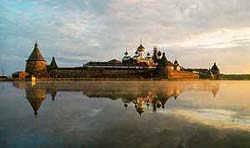Pearls of nature
The Solovetsk Islands
 The Solovetsk Islands form an archipelago. It includes six big islands and several small ones.
The Solovetsk Islands form an archipelago. It includes six big islands and several small ones.
The Solovetsk Islands are located near the Polar Circle, only 165 km away. Local climate is strongly influenced by the sea; that is why it is unexpectedly mild for the pre-polar zone. Average annual temperature here is +1,1C°. It is a little bit higher than on the continent at the same latitude. The coldest month - February, but even in February the average temperature does not fall below -10C°. All seasons on the islands are a little shifted; they are late for 2-3 weeks in comparison with the continent. Spring comes late. Summer heat delays approach of autumn. In winter the sea around the islands freezes, forming four - five-kilometer line of fast ice.
Due to the microclimate of the islands and the sea washing their coasts there are favorable conditions for development of many species of vegetation and fauna. Coniferous and deciduous woods prevail in the territories of the islands. Despite of the surrounding saline sea the islands have a lot of fresh water. There are 562 lakes different in size, form, colour, all of them are very picturesque. The fauna of the Solovki is not various, but rather numerous. Squirrels, hares, foxes and reindeer are most common here. The lakes are populated by perches, roach, pike, burbots. Seals, white whales are found in the sea. Rich algae plantations occupy the coastal line: kelp, fucus, ahnfeltia. They all have a great industrial value.
Development of these deserted islands of the White Sea began in XV century. Monks were the first residents here. In 1429 coenobites Savvaty and German landed and settled on the Big Solovetsk Island not far from Sekirna Mountain. The foundation of the Solovetsk Monastery was laid in 1436.
The Solovetsk Monastery played an important role in the history and culture not only of the Russian North, but also of the whole Russian State. During the first hundred years of existence the monastery intensively expanded its territories in Pomorye and by the end of XVI - the beginning of XVII centuries became the largest land owner of the North. Its lands were spreading along the White Sea coast from Arkhangelsk up to the Kola Peninsula; along the northern rivers Onega, Kem, Suma, Kereta. The monastery possessed rich economic base on the continent. The first constructions in the monastery were wooden, however, by the middle of XVI century stone buildings appeared. This stone construction began in the time of Philip (Kolychev), the monastery superior, later a well-known Moscow Metropolitan and a prominent public figure.
During four centuries, since XVI century, the Solovetsk Monastery was a frontier fortress and important outpost of the Russian State in the North. The Solovetsk Fortress more than once proved its fighting qualities. The Scandinavians, British and Danes were its main northern enemies.
In 1571 Swedish military ships appeared near the Solovetsk Islands. A voevode, four gunners, ten streletses, and also guns, cannon-balls, gunpowder and other ammunition were sent to the islands for protection. The monastery also built Sumsky, Kemsk and other fortresses for the same reason. The monastery streletses protected not only the islands, but also other coastal region territories. During the Pole-Lithuanian invasion (the beginning of XVII century) the monastery defended the North from the other direction. The monastery gave big sums to the state for assembling of troops and arming.
In the middle of XIX century the Solovetsk Fortress had to face an enemy again. In the summer of 1854 the English frigates came to the islands. Bombardment lasted for nine hours. The fortress stood firm under a hailstorm of cannon-balls from the ships. In 1855 English frigates came to the Solovki Islands again. The British made the monastery a number of demands. But the parley was no success. Today one can see an interesting historical monument with an inscription devoted to these events, 'The Parley Stone', placed on the seacoast, where the parley was held. Peter the Great visited the Solovetsk Islands twice. The monastery provided funds for Peter's Fleet construction, the monastery peasants served in Peter's Army. These Islands were the very starting point of Peter's legendary victorious campaign that was ended by a triumph on the Neva River. As a result Russia gained a way to the Baltic sea.
Since the time of Ivan the Terrible, during almost three and a half centuries there was a Solovetsk monastery prison where opponents of autocracy and official orthodox church were held. The tsar's prison on the islands ceased to exist only in 1903.
In 1920 when the monastery was closed the most valuable works of art were taken out from the islands and now they decorate the Armory Museum and Historical Museum in Moscow, Russian Museum in Saint-Petersburg. A part of art works is now shown at expositions of the Solovetsk Museum. During 20 years before the World War II the Special Solovetsk Camp operated within the precincts of the monastery. Outstanding representatives of Russian intelligentsia, writers, philosophers, engineers and clergymen languished here.
The Solovetsk Islands wrote their own glorious page of the WW II. In 1942 one of the first Sea Cadet's Schools of Russian Navy was organized here. It existed till 1945. More than 4000 sea cadets left this school.
The Solovetsk Fortress looks stately and powerful from the sea. Its unique silhouette cannot be easily forgotten. The Solovetsk Citadel represents a remarkable architectural ensemble. It is located on the coast of the cosy Blagopoluchiye Bay. Svyatoye Lake almost touches the walls from the east.
|